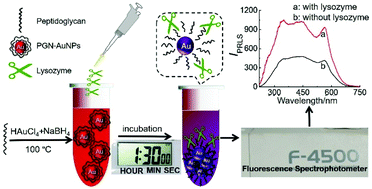Selective and sensitive detection of lysozyme based on plasmon resonance light-scattering of hydrolyzed peptidoglycan stabilized-gold nanoparticles†
Abstract
The simple, economic, rapid, and sensitive detection of lysozyme has an important significance for disease diagnosis since it is a potential biomarker. In this work, a new detection strategy for lysozyme was developed based on the change of the plasmon resonance light scattering (PRLS) signal of peptidoglycan stabilized gold nanoparticles (PGN-AuNPs). Peptidoglycan (PGN) was employed as a stabilizer to prepare PGN-AuNPs which have the properties of a uniform particle size, good stability, and a specific biological function. Due to the specific cleavage of lysozyme to PGN, a very simple specific and sensitive detection method for lysozyme was developed based on the PRLS signal of PGN-AuNPs after mixing with lysozyme for 1.5 h. The enhanced PRLS signals (ΔIPRLS, at 560 nm) increased linearly with increasing lysozyme in the range 5 nM to 1600 nM with the detection limit down to 2.32 nM (ΔIPRLS = 41.6397 + 0.5332c, R = 0.9961). When the PGN-AuNP based method was applied to assay lysozyme in authentic human serum samples, the recovery efficiency was 106.76–119.32% with the relative standard deviations in the range of 0.14–3.11%, showing good feasibility. The PGN-AuNP based method for lysozyme assay developed here is simple, rapid, selective, and sensitive, which is expected to provide a feasible new method for the diagnosis or prognosis of lysozyme-related diseases in a clinical setting.



 Please wait while we load your content...
Please wait while we load your content...